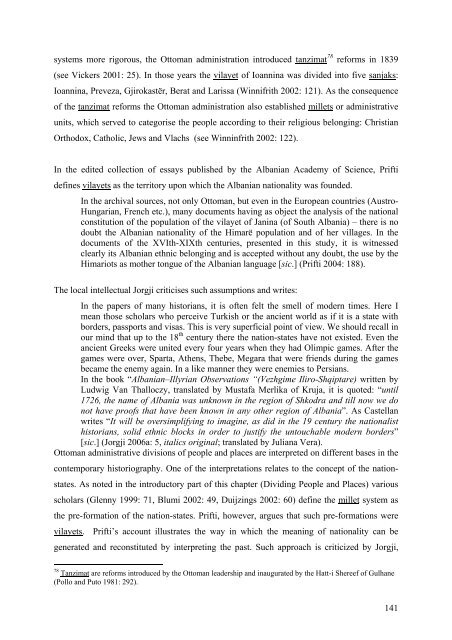university of nova gorica graduate school contested spaces and ...
university of nova gorica graduate school contested spaces and ...
university of nova gorica graduate school contested spaces and ...
Create successful ePaper yourself
Turn your PDF publications into a flip-book with our unique Google optimized e-Paper software.
systems more rigorous, the Ottoman administration introduced tanzimat 78 reforms in 1839<br />
(see Vickers 2001: 25). In those years the vilayet <strong>of</strong> Ioannina was divided into five sanjaks:<br />
Ioannina, Preveza, Gjirokastër, Berat <strong>and</strong> Larissa (Winnifrith 2002: 121). As the consequence<br />
<strong>of</strong> the tanzimat reforms the Ottoman administration also established millets or administrative<br />
units, which served to categorise the people according to their religious belonging: Christian<br />
Orthodox, Catholic, Jews <strong>and</strong> Vlachs (see Winninfrith 2002: 122).<br />
In the edited collection <strong>of</strong> essays published by the Albanian Academy <strong>of</strong> Science, Prifti<br />
defines vilayets as the territory upon which the Albanian nationality was founded.<br />
In the archival sources, not only Ottoman, but even in the European countries (Austro-<br />
Hungarian, French etc.), many documents having as object the analysis <strong>of</strong> the national<br />
constitution <strong>of</strong> the population <strong>of</strong> the vilayet <strong>of</strong> Janina (<strong>of</strong> South Albania) – there is no<br />
doubt the Albanian nationality <strong>of</strong> the Himarë population <strong>and</strong> <strong>of</strong> her villages. In the<br />
documents <strong>of</strong> the XVIth-XIXth centuries, presented in this study, it is witnessed<br />
clearly its Albanian ethnic belonging <strong>and</strong> is accepted without any doubt, the use by the<br />
Himariots as mother tongue <strong>of</strong> the Albanian language [sic.] (Prifti 2004: 188).<br />
The local intellectual Jorgji criticises such assumptions <strong>and</strong> writes:<br />
In the papers <strong>of</strong> many historians, it is <strong>of</strong>ten felt the smell <strong>of</strong> modern times. Here I<br />
mean those scholars who perceive Turkish or the ancient world as if it is a state with<br />
borders, passports <strong>and</strong> visas. This is very superficial point <strong>of</strong> view. We should recall in<br />
our mind that up to the 18 th century there the nation-states have not existed. Even the<br />
ancient Greeks were united every four years when they had Olimpic games. After the<br />
games were over, Sparta, Athens, Thebe, Megara that were friends during the games<br />
became the enemy again. In a like manner they were enemies to Persians.<br />
In the book “Albanian–Illyrian Observations “(Vezhgime Iliro-Shqiptare) written by<br />
Ludwig Van Thalloczy, translated by Mustafa Merlika <strong>of</strong> Kruja, it is quoted: “until<br />
1726, the name <strong>of</strong> Albania was unknown in the region <strong>of</strong> Shkodra <strong>and</strong> till now we do<br />
not have pro<strong>of</strong>s that have been known in any other region <strong>of</strong> Albania”. As Castellan<br />
writes “It will be oversimplifying to imagine, as did in the 19 century the nationalist<br />
historians, solid ethnic blocks in order to justify the untouchable modern borders”<br />
[sic.] (Jorgji 2006a: 5, italics original; translated by Juliana Vera).<br />
Ottoman administrative divisions <strong>of</strong> people <strong>and</strong> places are interpreted on different bases in the<br />
contemporary historiography. One <strong>of</strong> the interpretations relates to the concept <strong>of</strong> the nationstates.<br />
As noted in the introductory part <strong>of</strong> this chapter (Dividing People <strong>and</strong> Places) various<br />
scholars (Glenny 1999: 71, Blumi 2002: 49, Duijzings 2002: 60) define the millet system as<br />
the pre-formation <strong>of</strong> the nation-states. Prifti, however, argues that such pre-formations were<br />
vilayets. Prifti’s account illustrates the way in which the meaning <strong>of</strong> nationality can be<br />
generated <strong>and</strong> reconstituted by interpreting the past. Such approach is criticized by Jorgji,<br />
78 Tanzimat are reforms introduced by the Ottoman leadership <strong>and</strong> inaugurated by the Hatt-i Shereef <strong>of</strong> Gulhane<br />
(Pollo <strong>and</strong> Puto 1981: 292).<br />
141

















